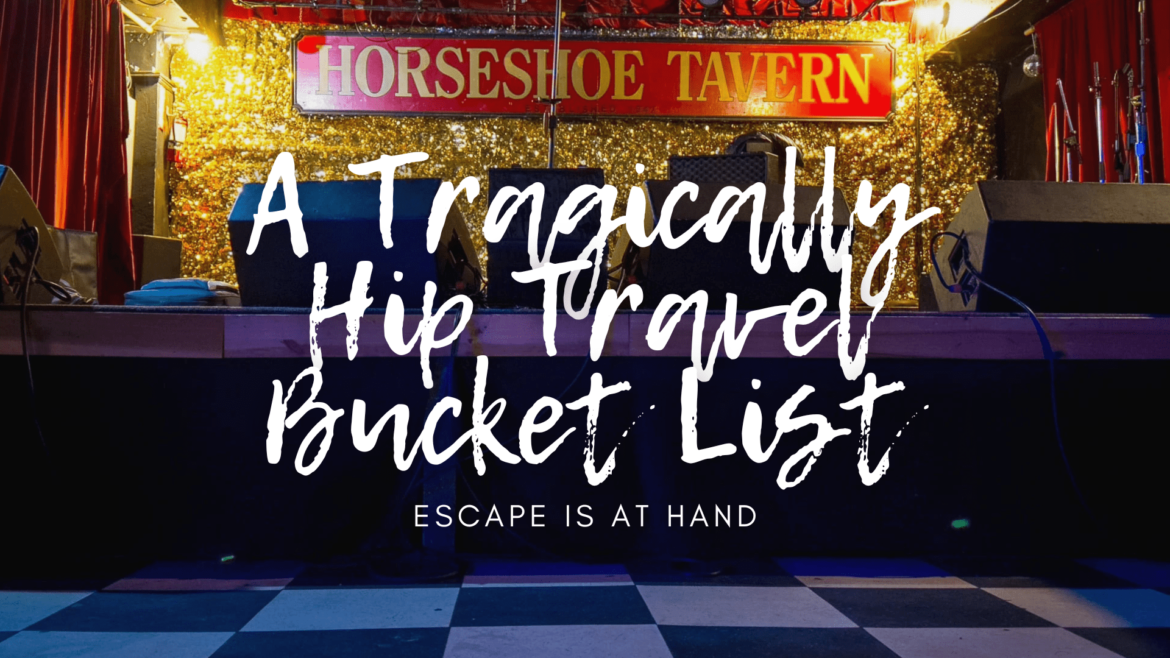Some pilgrimages aren’t religious, but they’re no less sacred. For me and one of my best friends—both lifelong Tragically Hip fans—our recent trip to Toronto was exactly that. We were there to see the remaining members of The Tragically Hip speak at a panel about their book This is Our Life.
It was more than just a night of stories; it was a tribute to a band that has been the soundtrack to countless Canadian road trips, mine included.
Our journey didn’t stop in Toronto. Like the band itself, we kept moving, making our way to Kingston, the Hip’s hometown and the site of their legendary final concert. Along the way, we visited sites that have become almost mythical to fans, locations immortalized in song and spirit.
This trip got me thinking about all the places The Tragically Hip have referenced, played, or left their mark on. I’ve crossed this country from Clayoquot Sound to Cape Spear, visiting many of these sites along the way, and now, I want to share them with you.
This isn’t just a Tragically Hip travel bucket list, it’s a love letter to Canada through the lens of its most beloved band.
British Columbia: From Clayoquot Sound to the Golden Rim Motor Inn

This Tragically Hip travel bucket list journey starts on the West Coast, where Clayoquot Sound, near Tofino and Ucluelet, serves as a symbolic gateway. It’s a place of raw natural beauty, referenced in Silver Jet, and also where Gord Downie played a charity concert for environmental conservation.
While here, it’s hard not to think of One Week, the 2008 road trip film where Joshua Jackson’s character travels across Canada after a terminal cancer diagnosis—fitting and also eerie as Gord himself made a cameo in the film. Highly recommend if you have not seen it.
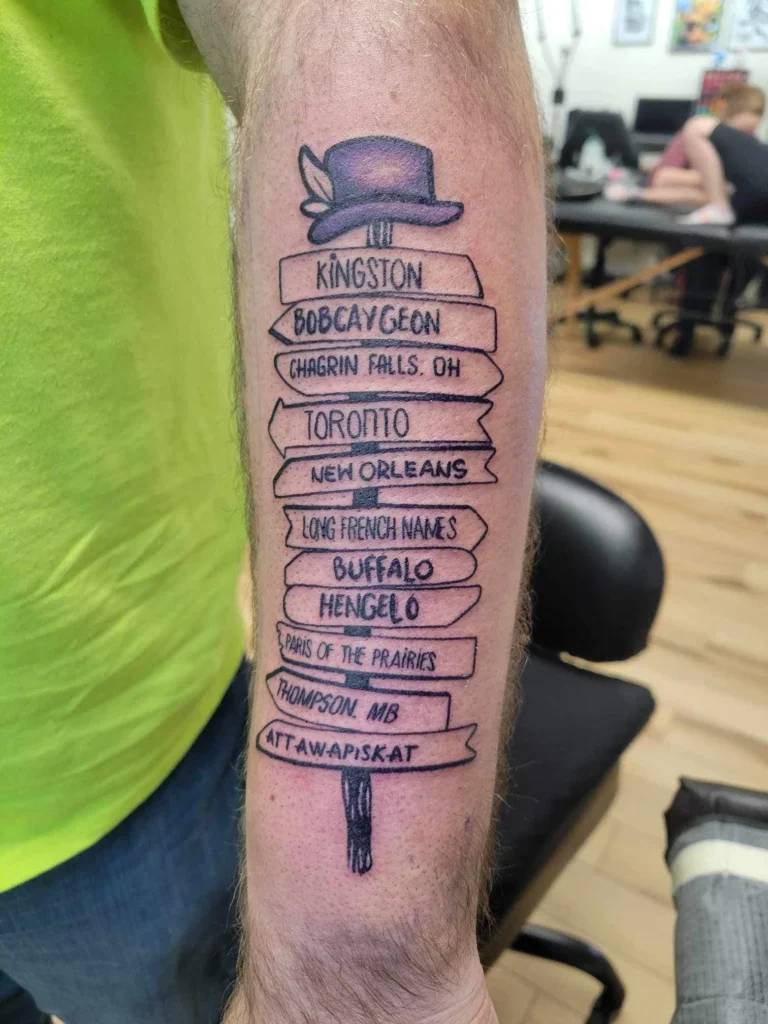
On Vancouver Island, you’ll find a bench dedicated to The Hip in Comox, and further inland, a mural in Sicamous, BC. I made a point of stopping at the latter on a cross-country road trip just to see this tribute, and it was worth the short detour.
Vancouver Divorce, from Gord Downie’s solo album Coke Machine Glow (2001), should also be mentioned here. The song uses Vancouver as a metaphor for the end of a relationship and contains references to the Last Spike and Tim Hortons, making it a distinctly Canadian reflection on heartbreak.
If you’re heading toward the Rockies, stop by the Golden Rim Motor Inn in Golden, BC—immortalized in The Luxury. This song, from Road Apples (1991), references the real Golden Rim Inn, a roadside motel where the band once stayed after their tour bus broke down in the mountains.
Today, the building is a Days Inn, but it still retains the nostalgia of countless road trips past.
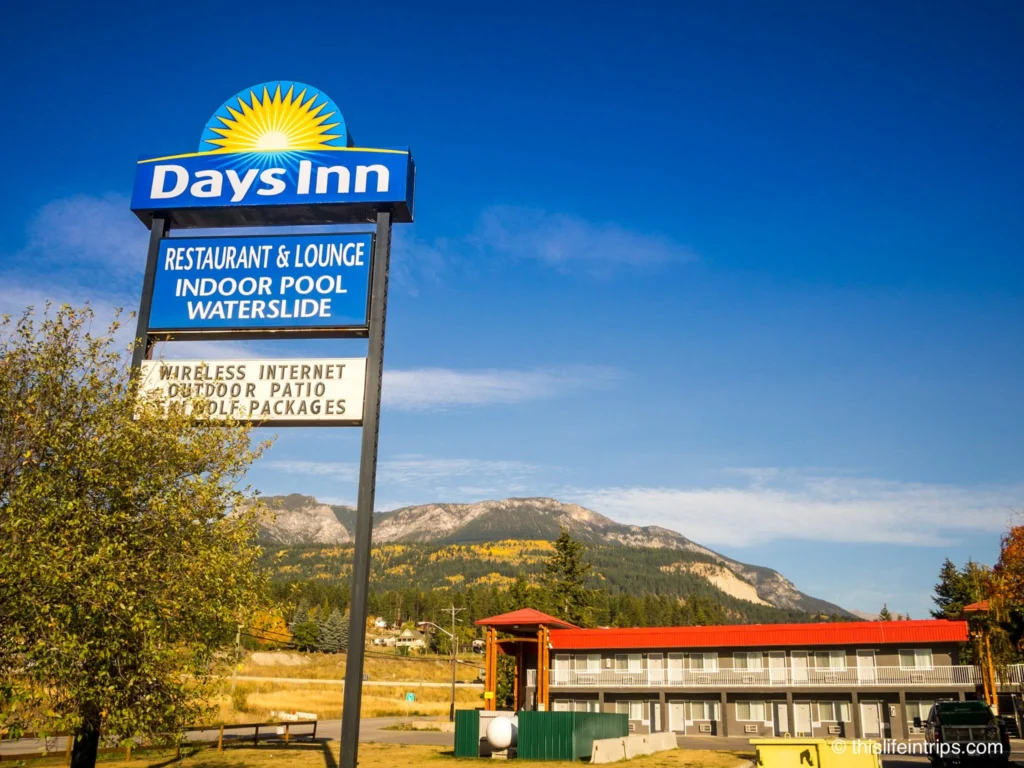
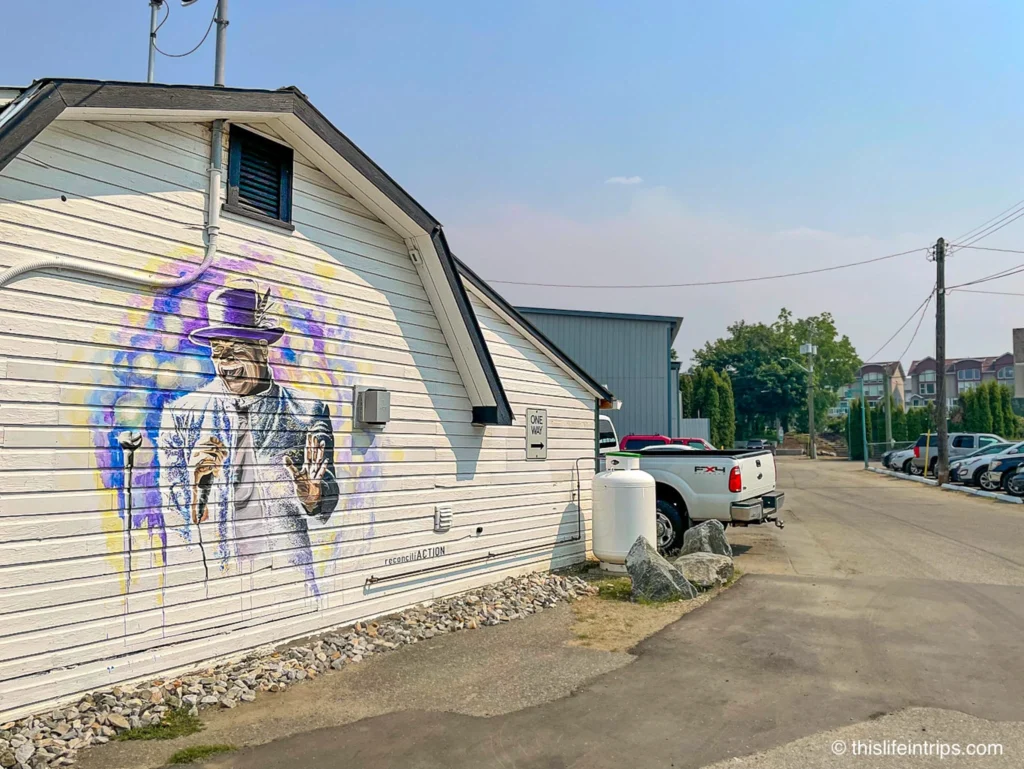
Alberta: Edmonton, Calgary, and the Cold of the North
The first time I saw The Tragically Hip live was in Edmonton—a moment that cemented my love for the band. Until then, Gord’s legendary rants and moves were just stories I’d heard. Seeing them firsthand was something else.
I would go on to catch them again at outdoor festivals across Alberta, each show a reminder of the raw energy and power of their music in a live setting. That said, Alberta doesn’t get referenced all that often in their music.
Calgary is specifically referenced in Take Forever, where Gord sings about it being the place to have a heart attack. Interestingly, a University of Calgary study once determined that Calgary is one of the best places in Canada to have a heart attack due to its access to life-saving angioplasty. A morbid yet fitting connection to the song’s lyrics.
Athabasca, in northern Alberta, is referenced in The Depression Suite, the longest song in The Hip’s discography. I spent a lot of time traveling through northern Alberta for work, and I can attest that the bleakness captured in the song’s lyrics is real—especially in the dead of winter, when the cold is relentless and the isolation hits hardest.
Saskatchewan: The Paris of the Prairies
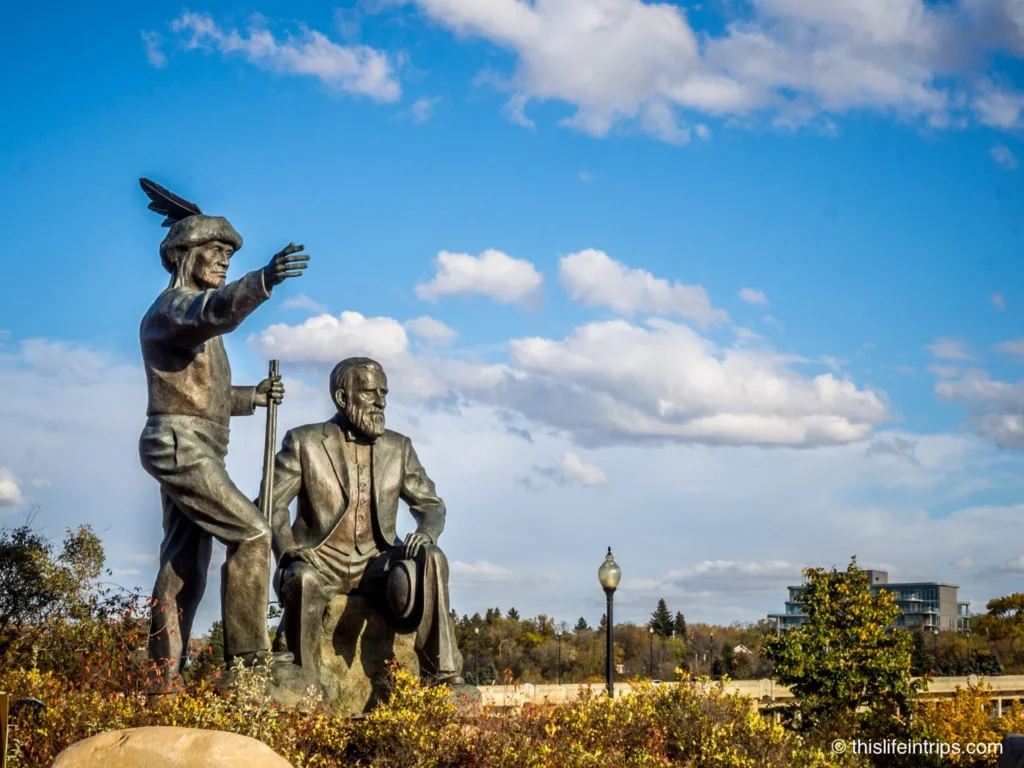
Saskatoon was immortalized in Wheat Kings, a song about the wrongful conviction of David Milgaard. Dubbed the “Paris of the Prairies,” Saskatoon remains a place where the echoes of that song can be felt in the wind over the South Saskatchewan River and through the weathervanes of the province.

The song speaks to injustice, resilience, and ultimately, redemption, as Milgaard was released from prison in 1992 after spending more than two decades behind bars for a crime he did not commit. I’ve stayed in Saskatoon multiple times and always find myself humming the opening lines as I watch the prairie sky stretch endlessly overhead.
Manitoba: The Hundredth Meridian and Thompson Girl’s Northern Spirit
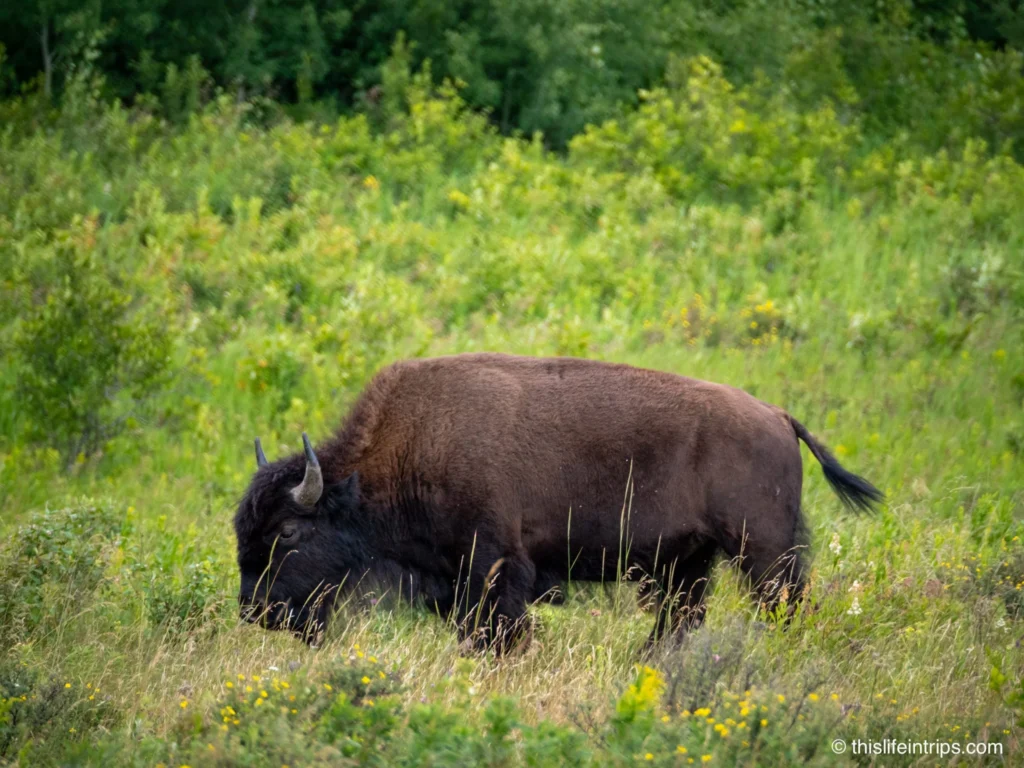
For fans wanting to venture deep into Canada’s northern heart, Thompson, Manitoba, stands out in Thompson Girl. Located at 55 degrees latitude, the city’s official motto claims it’s “where opportunity is endless,” but the song’s narrator paints a different picture, describing winter as a siege to be endured.
Downie captures the harsh reality of life in the North with lyrics referencing being “stranded at the Unique Motel” and the relentless cold—“Looks like Christmas at 55 degrees / This latitude weakens my knees.”
He also drew parallels between the song’s themes and life on the road, which is fitting for this Tragically Hip Travel Bucket List.
In an interview with the CBC in 1999, Gord stated “This is grunt work. What I’m doing is the daily life. It’s where the grist is. It’s in the travelling.” That mix of isolation and resilience—whether in a frozen northern town or endless touring—runs deep in the Hip’s storytelling.
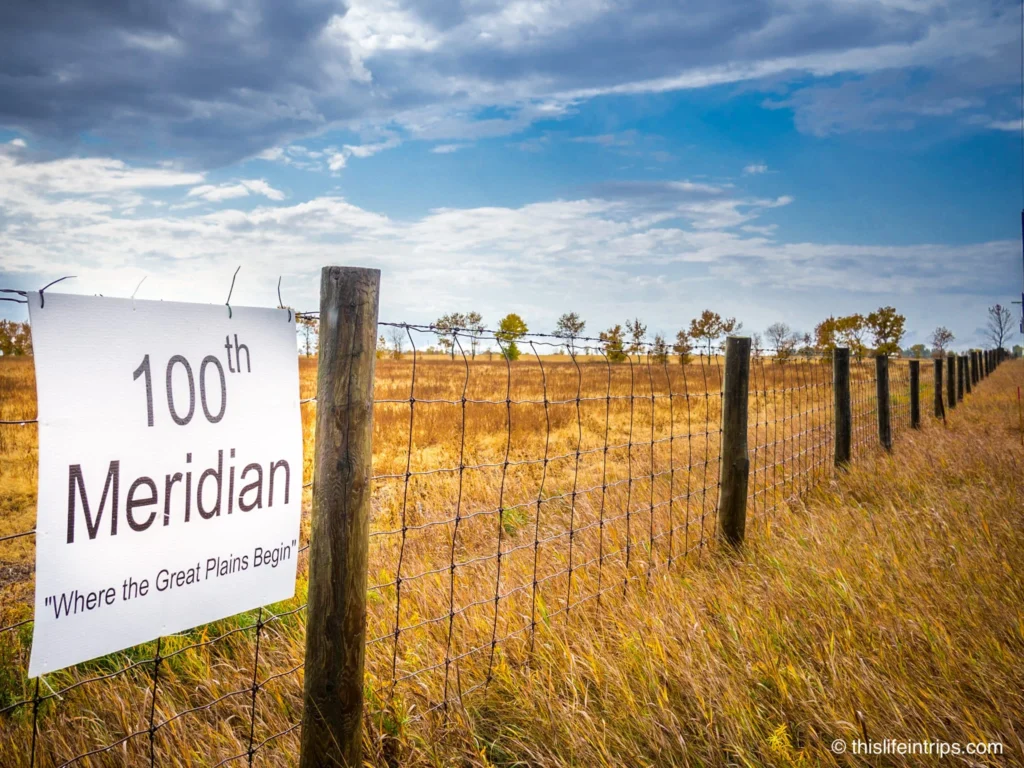
Manitoba is home to a significant landmark for fans of The Tragically Hip: the 100th meridian. This line of longitude, referenced in their song At the Hundredth Meridian, historically marks the transition between the moist, urban east and the arid, rural west of North America. It has also come to symbolize a convenient political dividing line between the liberal-leaning east and conservative-leaning west.
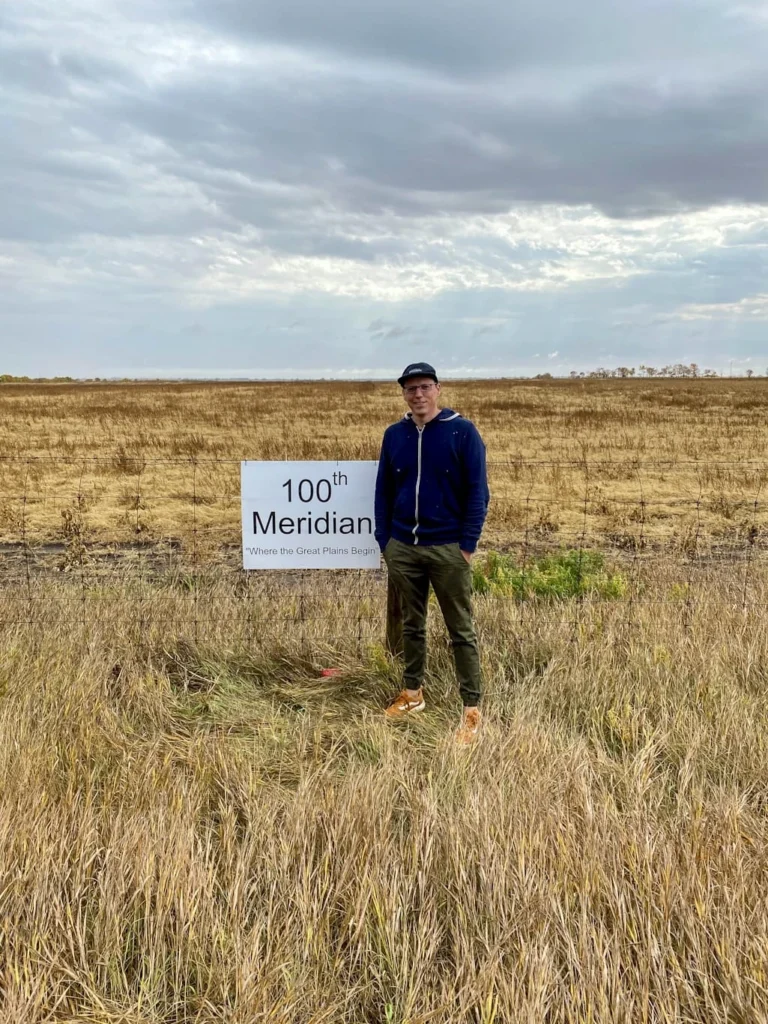
For geocaching enthusiasts, there’s a hidden cache near this spot, offering a hands-on way to connect with Fully Completely’s At the Hundredth Meridian. It’s a unique experience that blends the physical landscape with the cultural significance of The Tragically Hip’s music.
I’ve stopped by a couple of times to sign the logbook, though on my last visit, I found the plastic bin waterlogged. If no one beats me to it, I’ll be sure to replace it on my next trip through.
You can find the sign just west of Brandon city limits on the south side of the Trans-Canada highway, down a corduroy road.

There are so many fantastic lines in the song worth diving into. I checked out A Museum After Dark, a fantastic resource dedicated to exploring the meaning behind The Tragically Hip’s music.
Fittingly, “driving down a corduroy road,” a term with two connotations in Canadian history. It describes dirt roads imprinted by wooden wheels of wagon trains, leaving straight lines resembling corduroy fabric. Alternatively, it refers to roads made passable by laying planks or logs across muddy areas, creating a ridged surface similar to corduroy.
Additionally, the lyric “I remember Buffalo, I remember Hengelo” alludes to two notable events in the band’s history. The reference to Buffalo is debated but may relate to a 1993 incident where a shoe was thrown at Gord Downie during a performance, causing him to leave the stage. The mention of Hengelo recalls a show in the Netherlands where the band arrived late and intoxicated due to getting lost en route, resulting in a legendary bootleg recording.
Ontario: The Heart of The Hip
Ontario is where The Tragically Hip was born, where their music was crafted, and where their legacy, arguably, remains the strongest. The province is referenced in numerous songs, and I’ve had the opportunity to visit many of these places, each one adding another layer to my appreciation of the band.
Let’s travel across the province—but mind the 401, as Day For Night‘s haunting track Titanic Terrarium warns, when the weather gets bad.
Kingston: Everybody Was In It
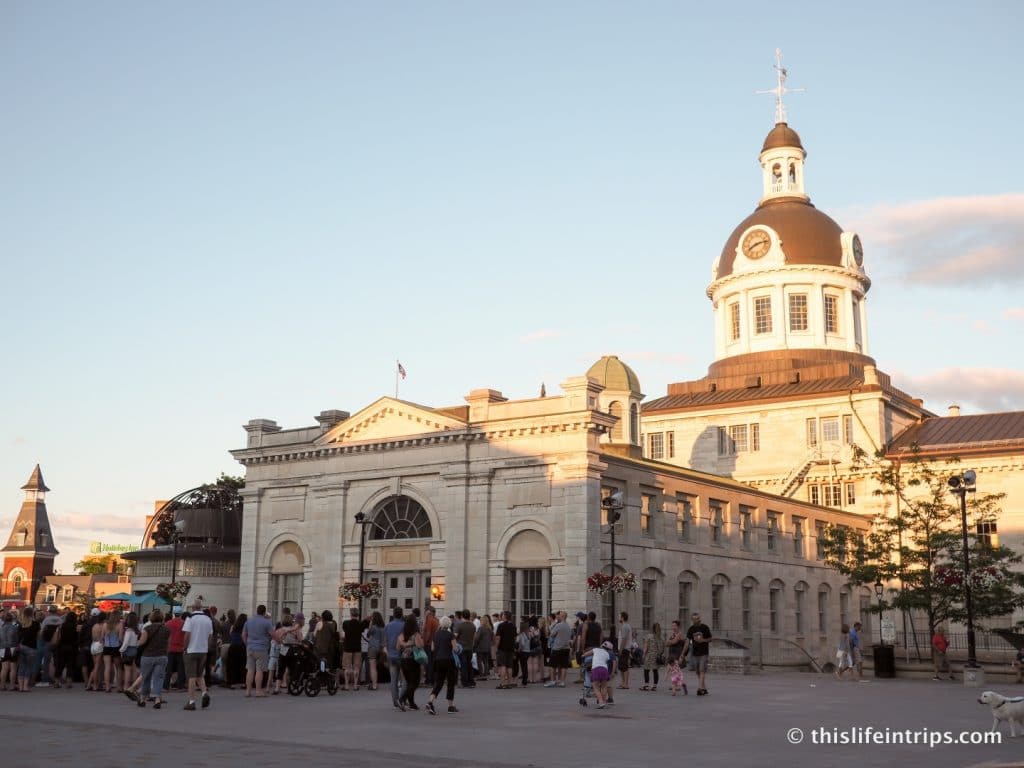
Kingston is the epicenter of The Tragically Hip’s legacy. Walking through Market Square, it’s impossible not to think of Up to Here‘s Blow at High Dough, with the lyric, “Everybody was in it for miles around.” The scenes of the viewing party here from the last concert still brings me chills.
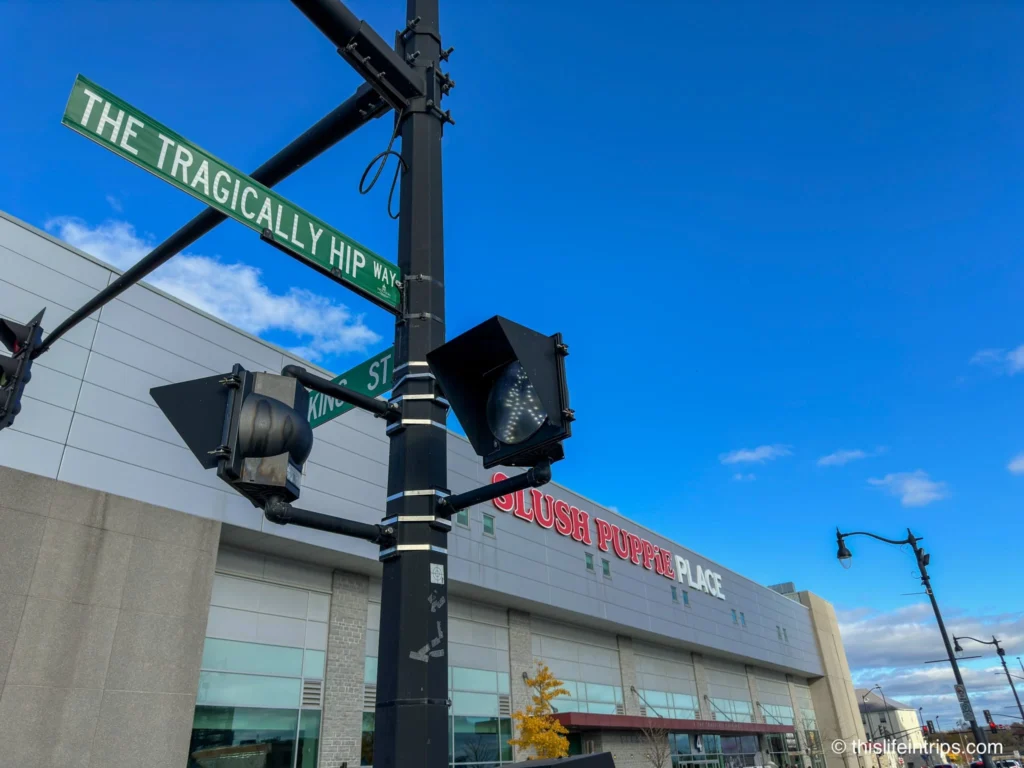
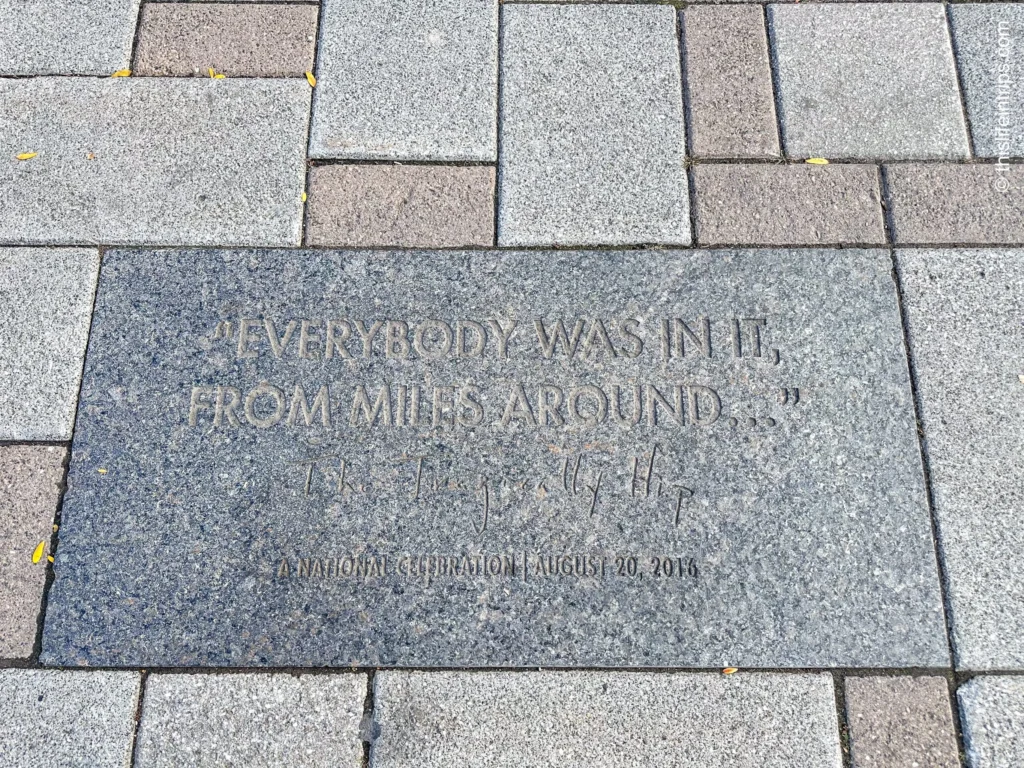
The square now has a plaque commemorating the Tragically Hip’s final concert, a historic night that saw the entire country come together. Nearby, the newly erected Tragically Hip sign allows fans to be the “I” in Hip—a perfect photo opportunity for any diehard fan.
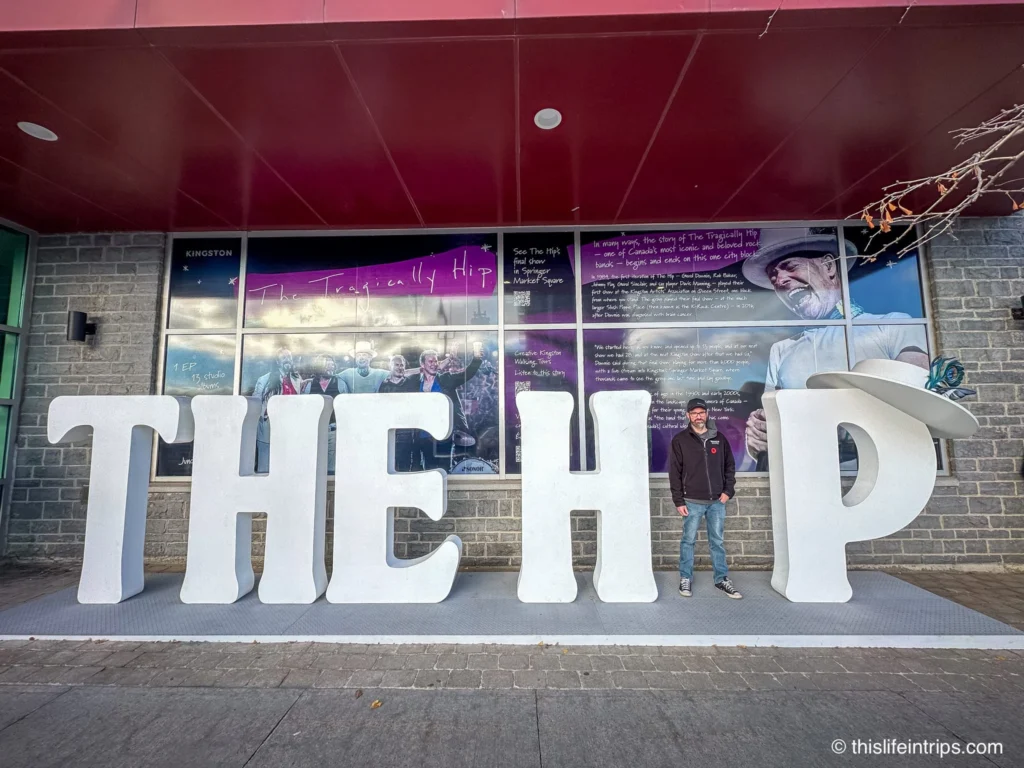
Gord Downie Pier, named in his honor, stands as a powerful tribute to his love for the water and his deep connection to Kingston, the city he called home. Located at Breakwater Park along Kingston’s waterfront, the pier extends into Lake Ontario, offering stunning views of the shoreline and a peaceful space for reflection—something that feels fitting given Downie’s poetic spirit.
The pier is part of a larger revitalization of the waterfront, designed as a public gathering space where people can walk, swim, and take in the natural beauty that Downie so often referenced in his lyrics. It’s also Canada’s first deep-water urban swimming pier, reinforcing the Hip frontman’s passion for both environmental conservation and making spaces more accessible to the public.
On warm summer days, locals and visitors alike can be found jumping from the pier into the lake, a simple but joyful act that somehow feels in tune with the way Downie approached life—with enthusiasm, appreciation, and a love for Canada’s landscapes.
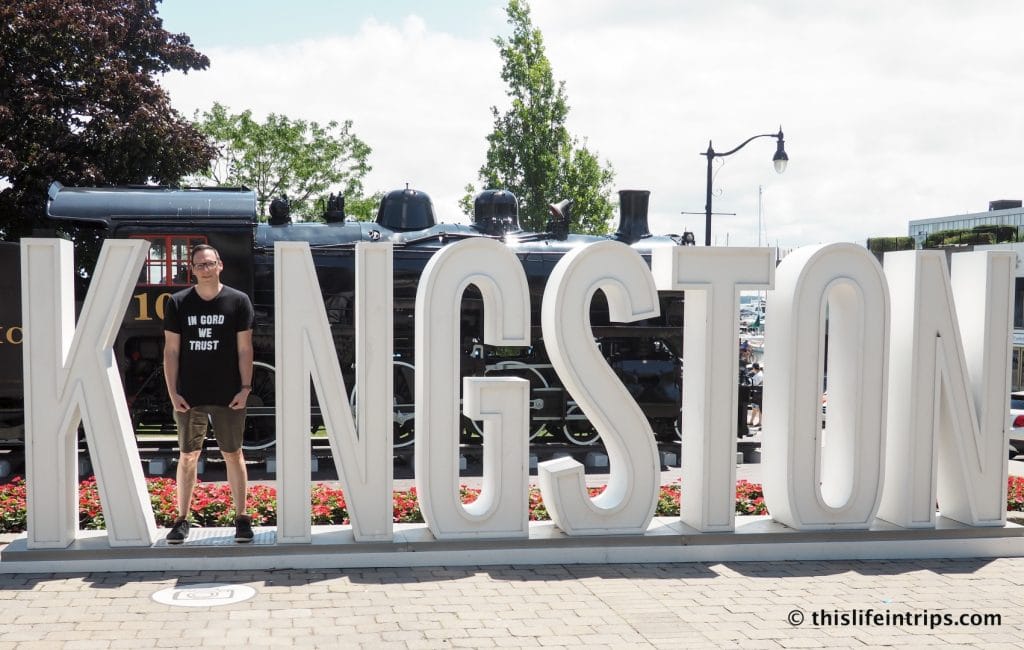
For fans looking to take home a piece of The Hip’s legacy, The Whit in Kingston is the place to go. This local shop carries an incredible collection of Tragically Hip memorabilia, from vintage posters to exclusive merchandise. I never leave Kingston without something from this local shop.
Hip Attractions Near Kingston
Just outside Kingston sits The Bathouse Studio, The Tragically Hip’s legendary recording sanctuary. More than just a studio, it’s a piece of Canadian music history. Originally a historic coach house from the 19th century, the band converted it into a fully equipped recording studio in the mid-1990s, turning it into a creative hub not just for themselves but for a long list of celebrated Canadian artists.

While it’s not open for tours, I’ve stopped outside, imagining the magic that unfolded within those walls. Iconic Hip albums like Phantom Power, Music @ Work, and In Violet Light were recorded here, along with work from artists like Sam Roberts Band, Blue Rodeo, and The Arkells.
The Bathouse isn’t just a studio—it’s a place where some of Canada’s most defining sounds were shaped.
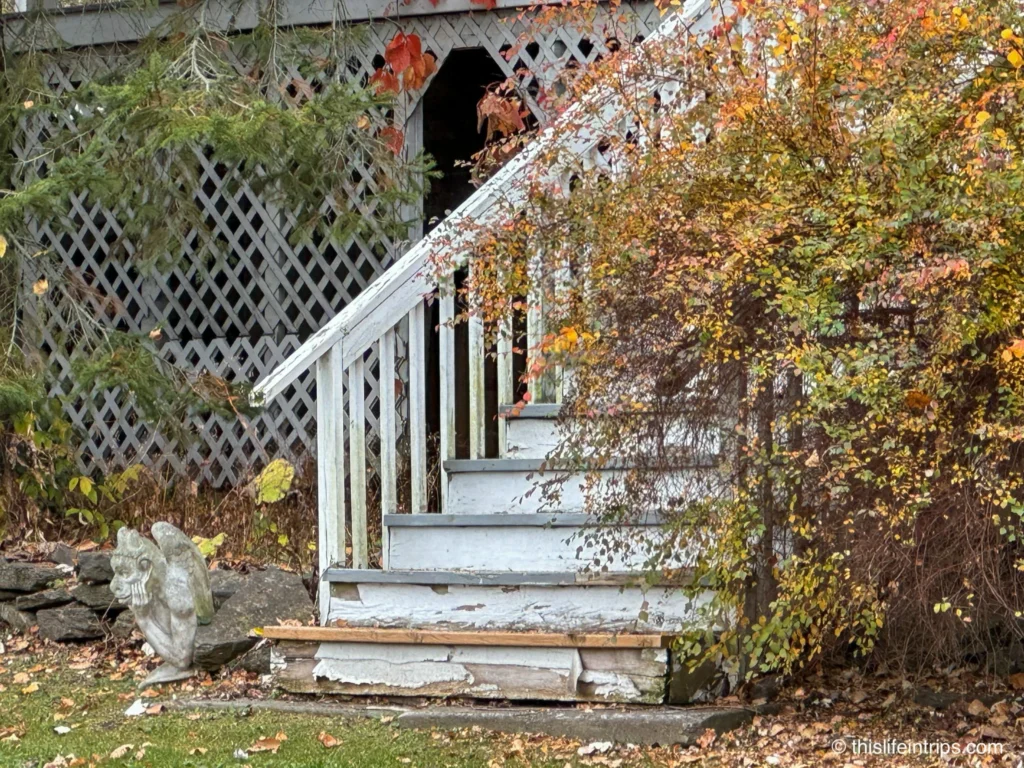
It’s easy to see why The Hip chose this tranquil lakeside retreat as their creative refuge. The seclusion, the history, and the raw energy of the space must have fueled the band’s inspiration in ways that can still be heard in their music today.

38 Years Old brings us to Millhaven Maximum Security Prison, not far from Kingston. I’ve driven past it a few times, and every time, I can’t help but think of the haunting lyrics. Those interested in the darker side of Kingston’s history can take a tour of Kingston Penitentiary, a chilling experience that will make you appreciate the storytelling in 38 Years Old even more.
Finally, a short ferry ride from Adolphustown brings you to Glenora, a small community on the southern shore of the Bay of Quinte, immortalized in Moon Over Glenora. Before a live performance in 2010, Downie said the song was about the ferry operator and the monotony of riding the boat back and forth while everyone else gets to leave—though, as always, he may have been ad-libbing. Either way, the imagery of the quiet ferry crossing and the stillness of the water perfectly fit the poetic style of Downie’s lyrics.
Toronto: With it’s Checkerboard Floors
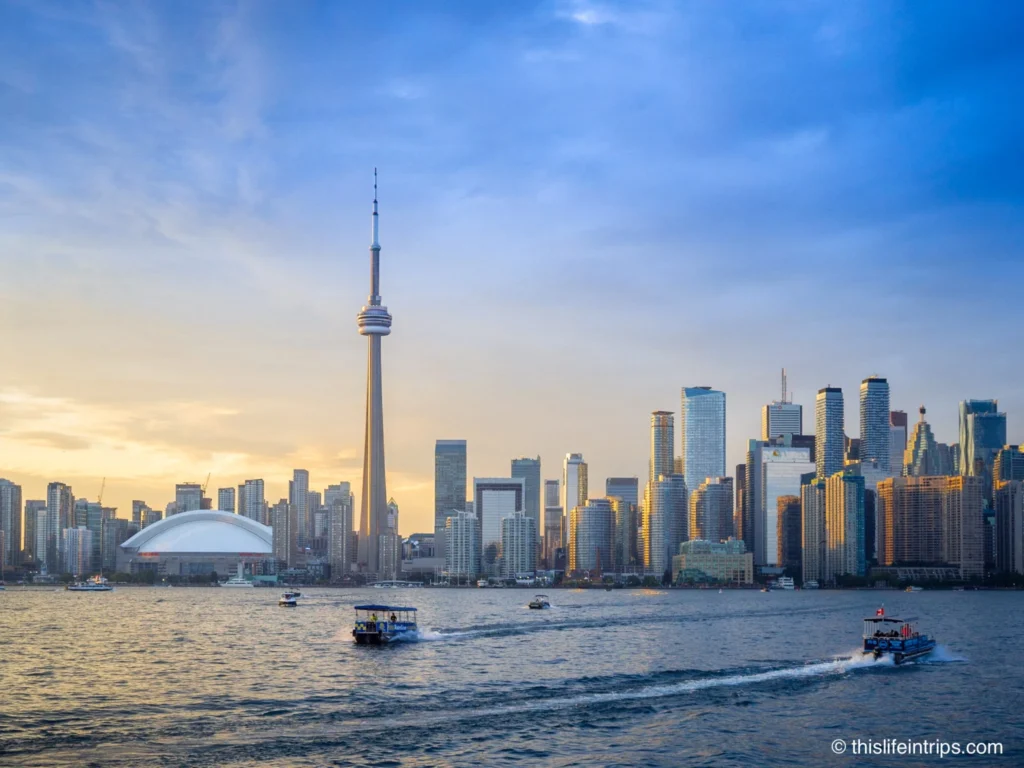
Toronto, of course, is rich with Hip history. The Horseshoe Tavern, referenced in Bobcaygeon as “that night in Toronto with its checkerboard floors,” remains one of the city’s most legendary music venues. It’s also one the Hip played at several times.
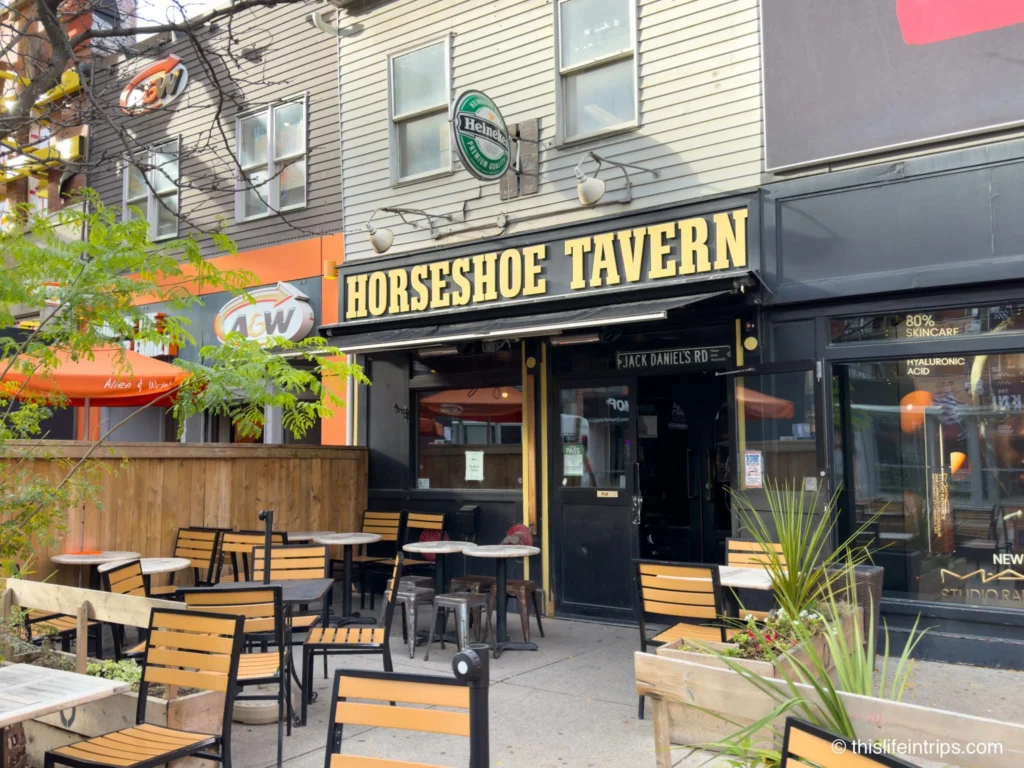
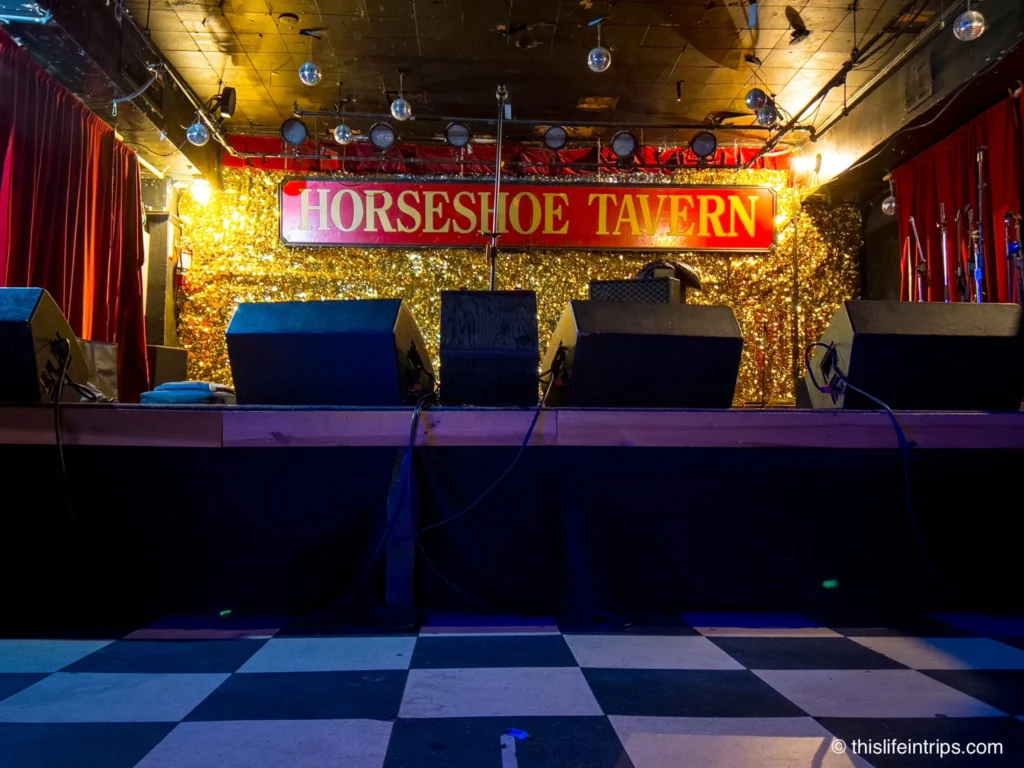
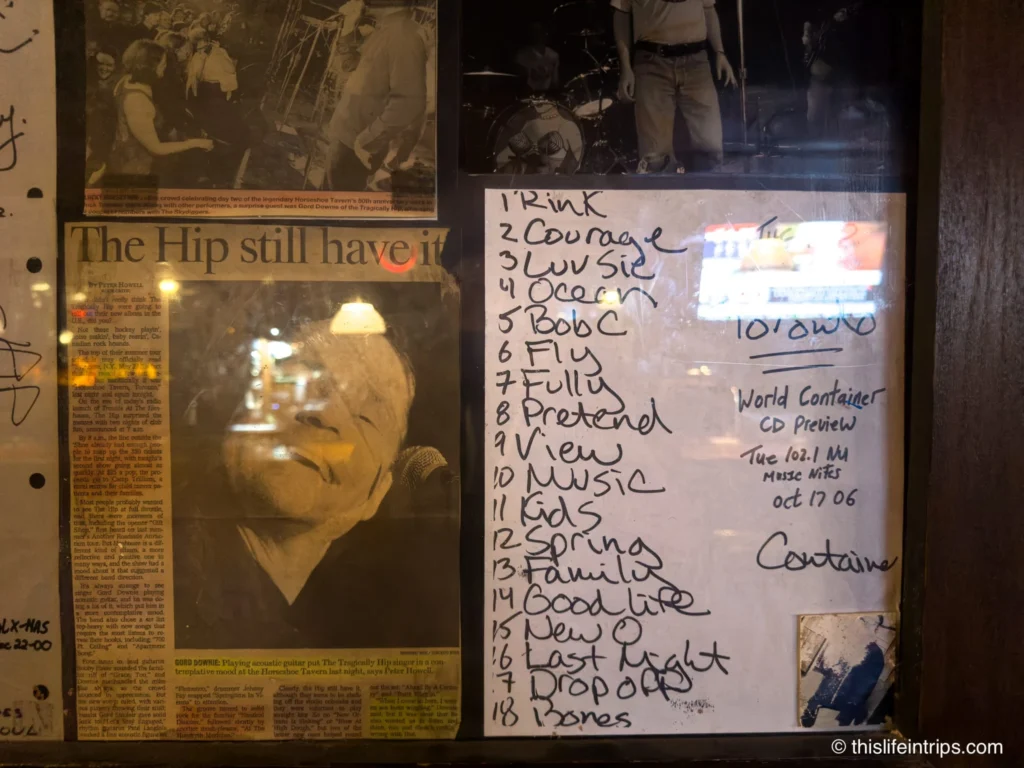
Inside you will find plenty of evidence of this including set lists from shows played there. I’ve been lucky enough to stand on that very floor, soaking in the atmosphere of a venue that has hosted countless legendary acts, including The Hip in their early days.
For a great view inside of the Horseshoe Tavern, check out the video for No Solace from Gord’s posthumous Away is Mine.
While The Hip played many of Toronto’s iconic venues, from Massey Hall to the Air Canada Centre, their presence is felt strongest in the memories of the fans who packed those venues time and time again.
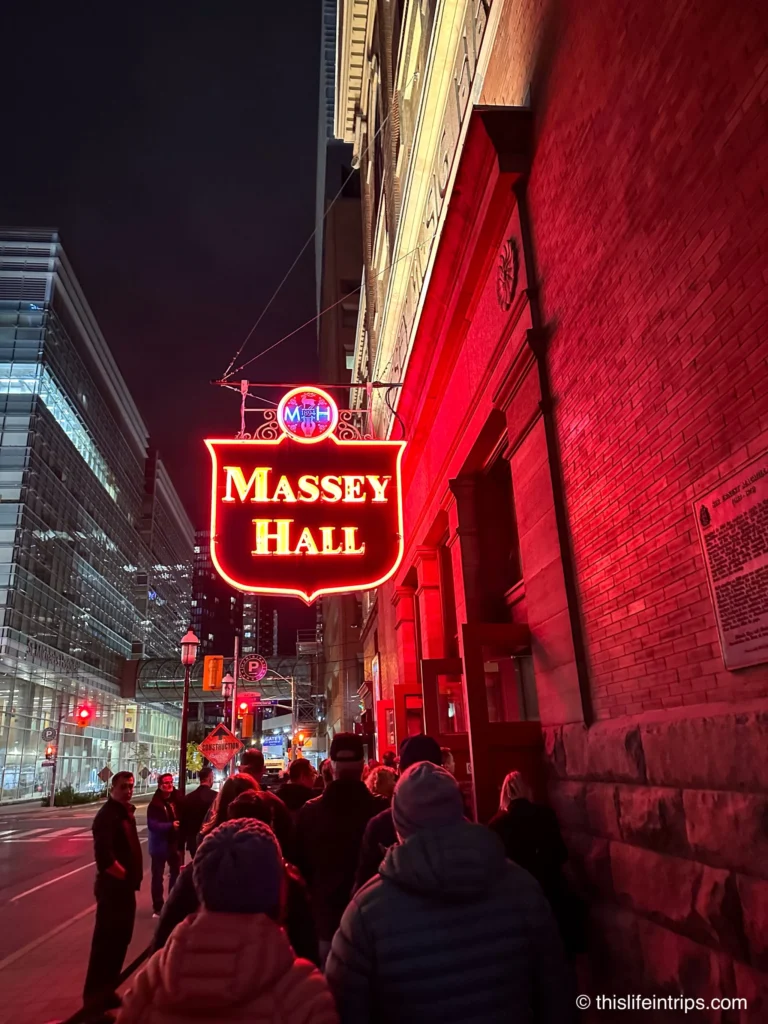
I finally got to visit Massey Hall for a Tragically Hip panel discussing their book This is Our Life. What an experience—seeing the surviving members on stage and sharing the night with Canadian icons like Ron MacLean and Jay Baruchel in the crowd. It was a night of reflection, storytelling, and a celebration of a band that has meant so much to so many.


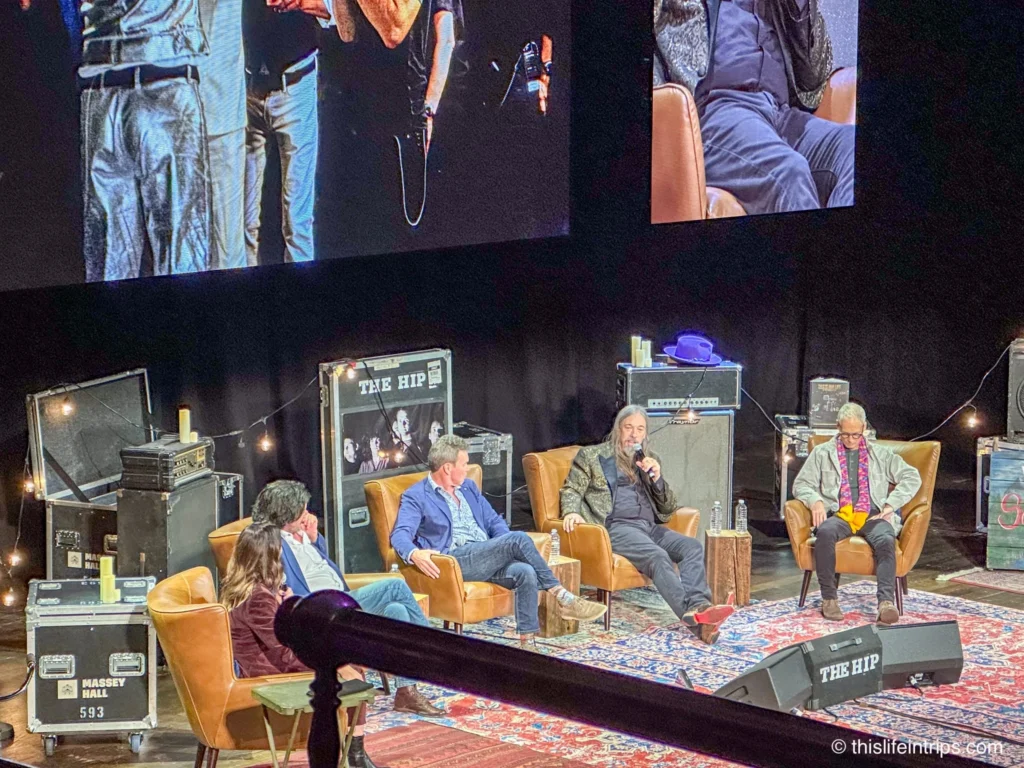
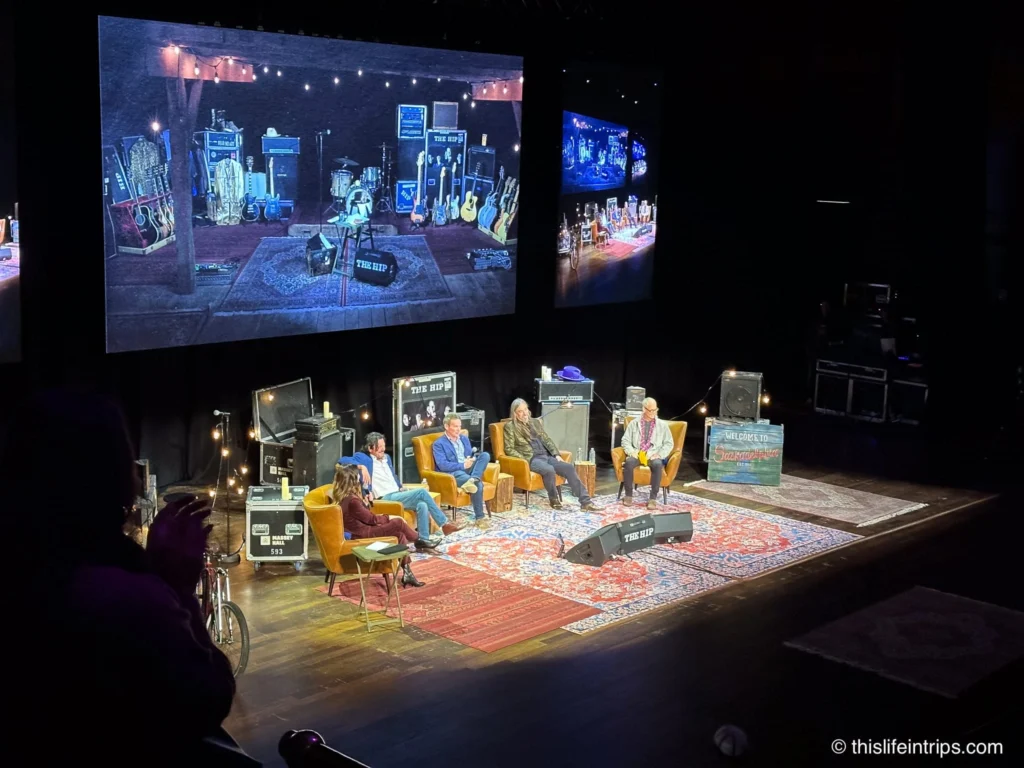
The song Toronto #4 from Music @ Work is another nod to the city, though its meaning runs deeper than its title suggests. Written about Gord Downie’s grandmother, who was the rock of the family, the song is a heartfelt reflection on memory, love, and loss. Its soft, melancholic tone and vivid lyrics showcase Downie’s ability to weave deeply personal stories into his music, turning a simple title into something profoundly emotional.
Beyond his work with The Tragically Hip, Gord’s solo career also featured Toronto references, including “Christmas Time in Toronto,” a track from his 2001 album Battle of the Nudes. His solo work often explored more experimental and introspective themes, showcasing his storytelling in ways that extended beyond the band’s signature sound.
Southern Ontario Hip References
Ontario is a vast province, and The Tragically Hip’s music reaches into every corner. Bobcaygeon put the small town of the same name on the map for many fans. All because Gord was looking for a place to rhyme with the word constellation.
I made a specific detour to visit, standing by the town’s iconic sign while playing Bobcaygeon on repeat, thinking about the small-town charm and the song’s poignant lyrics about love, distance, and realization.
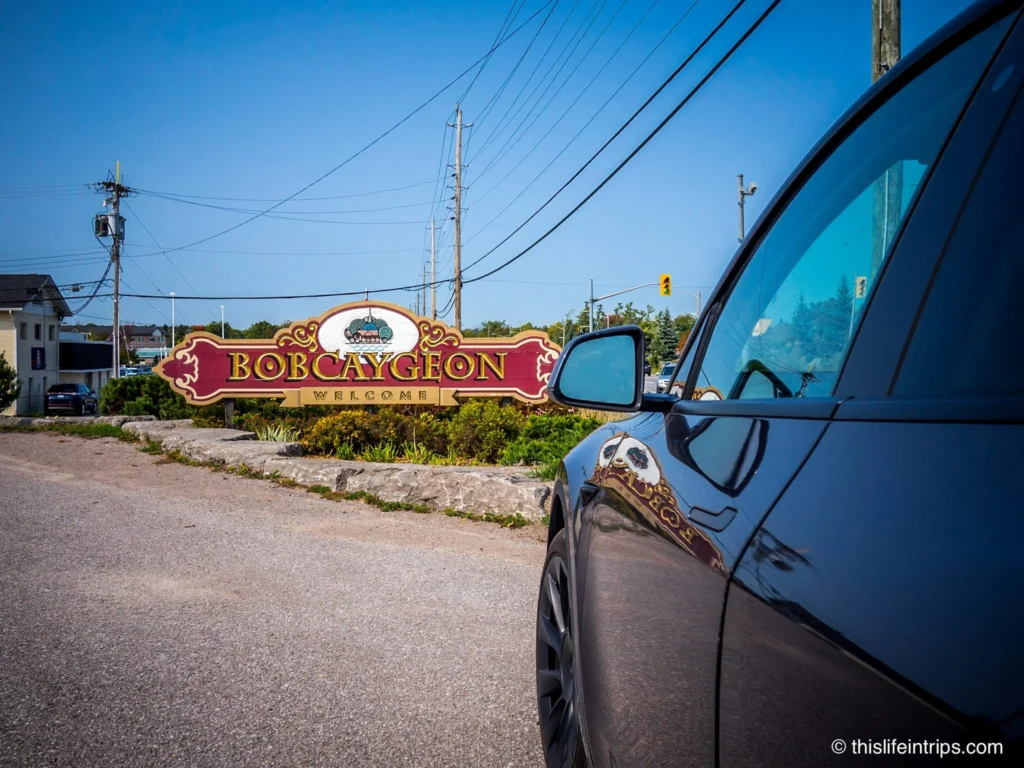
Meanwhile, Sarnia, referenced in In Sarnia from the amazing final album Man Machine Poem, is a city I know well, having family there. Although another location was picked based on rhythm (original title was to be Insomnia), it’s still touching to see the nod.
Northern Ontario: The Hip’s Many Wilderness Ties
Northern Ontario has always had a rugged and poetic presence in The Hip’s music, and for me, this connection is personal—both my parents’ family are from the region, and I’ve spent a lot of time here.
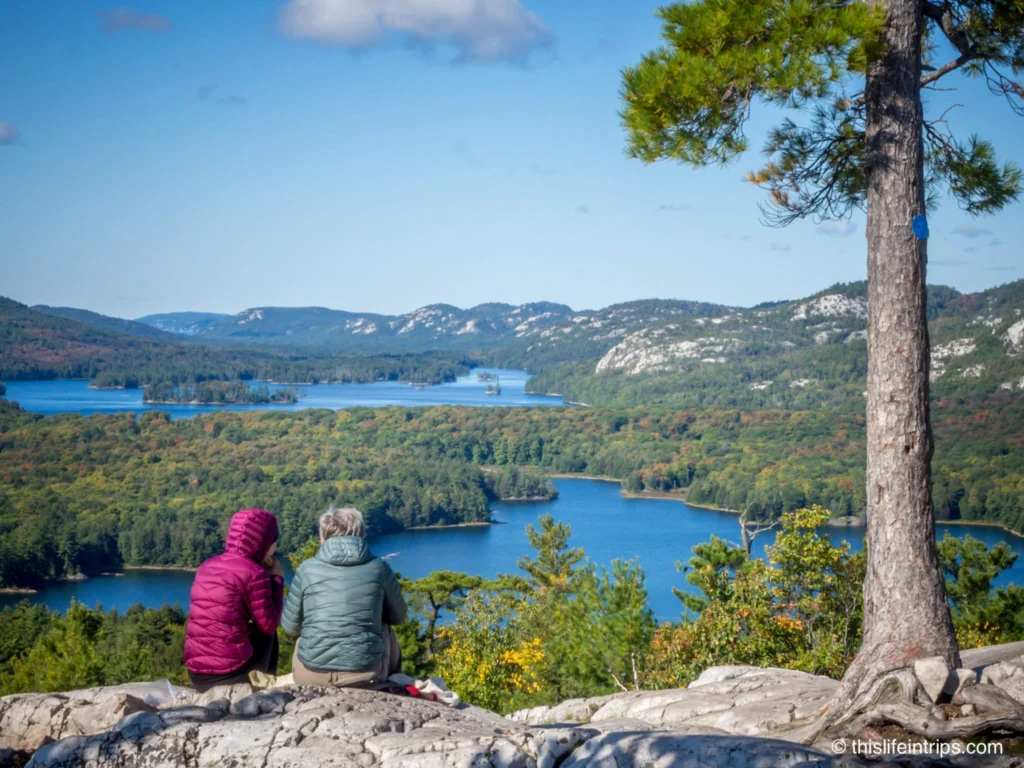
Algonquin Park, about 300 km from The Hip’s hometown, makes an appearance in The Bear. The song tells of a bear that finds itself stranded on an island, who is hungry and comes across some campers. It is thought that this loosely references the last fatal bear attack in the park in 1991.
Bears appear throughout The Hip’s discography, from In Between Evolution’s (one of my fav albums) Gus: The Polar Bear from Central Park to Problem Bear, and even Downie being stalked by a polar bear in the World Container’s Yer Not the Ocean music video.
Sudbury, the largest city in northern Ontario, is featured in The Dance and Its Disappearance. The song references the city’s distinct “orangey glows and Sudbury yellows,” which could refer to its famous Flour Mill silos, the sun, pollution, or even the unique shade of paint known as Sudbury Yellow.

“In orangey glows And Sudbury yellows We are the dance And its disappearance”
Moonbeam, a small town in northern Ontario, gets a mention in Fly, and if you ever find yourself in that part of the province, you’ll spot a massive UFO roadside attraction—an unexpected but memorable stop for any Hip fan.
Further north, Goodnight Attawapiskat (Now for Plan A) highlights The Hip’s long-standing advocacy for Indigenous issues. The band traveled to Fort Albany, near Attawapiskat, in 2012 as part of a celebration of Cree culture and education.
The song references “diamond dazzling,” likely a nod to the nearby Victor Diamond Mine—a source of controversy due to concerns over whether local Indigenous communities see a fair share of the economic benefits.
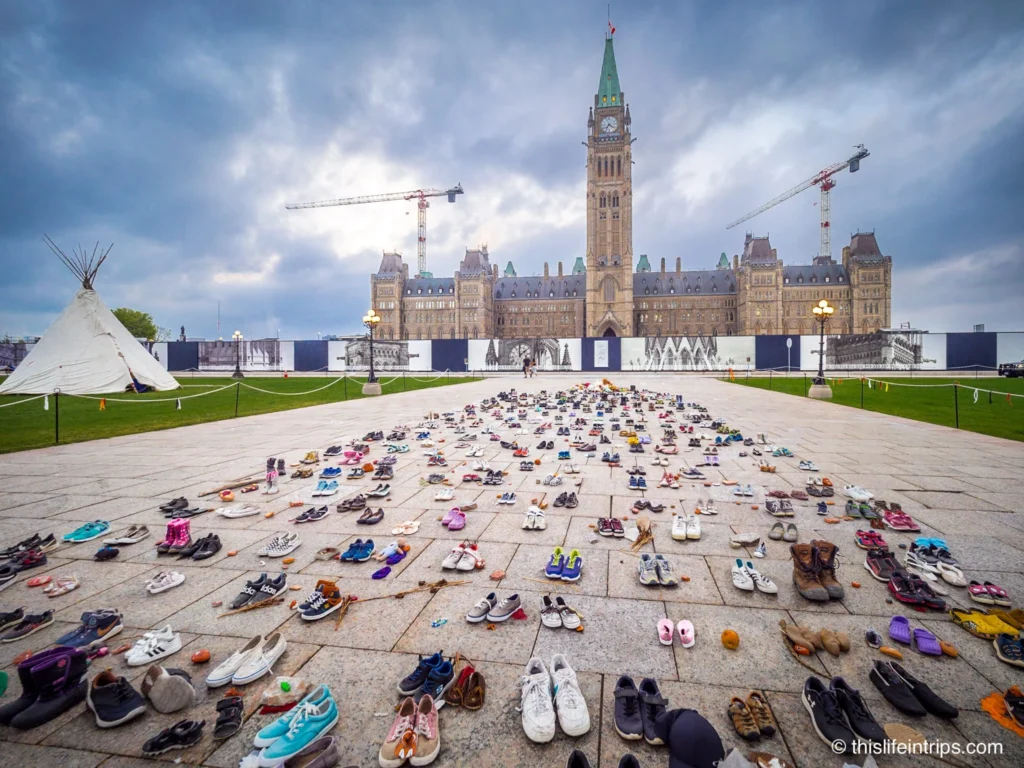
“I’m maybe not painting an accurate picture,” Downie told CBC in 2012. “But at least I’m trying to paint a picture that isn’t the picture we all kind of just accept and forget about.”
The Hip also took a stand in their early music. Born in the Water (Road Apples) lashes out at Sault Ste. Marie, Ontario’s 1990 declaration that it was an English-only city, a controversial decision made during the national debate over the Meech Lake Accord. The Soo’s declaration was struck down by the courts, and a subsequent mayor later apologized for it.
Everywhere I’ve traveled in Ontario, I’ve found echoes of The Hip’s music. Their songs paint a vivid picture of the province, and standing in these places makes their lyrics resonate even more. Whether you’re a lifelong fan or a newcomer to their music, a Tragically Hip road trip through Ontario is an unforgettable experience.
Quebec: Three Pistols and Montreal
Quebec has been referenced a couple of times in The Tragically Hip’s music, and Three Pistols is no exception. The song pays tribute to Trois-Pistoles, a small town on the St. Lawrence River, and also references the famous Canadian painter Tom Thomson.

I was lucky enough to spend 10 days living with a family in Trois-Pistoles to improve my French, and the entire time, Three Pistols played in my head. Fun connection—it’s also the song I was interviewed about on the TTH Top 40 Podcast!

In Looking for a Place to Happen, Gord Downie name-drops the French explorer Jacques Cartier, who sailed past the Gaspé Peninsula in 1534. I was lucky enough to road trip around the Gaspésie region myself, and I can honestly say it’s one of my all-time favorite drives. The landscapes are wild, dramatic, and totally unforgettable.
In the town of Gaspé, you’ll find a statue commemorating Cartier and a replica of the original wooden cross his crew erected to claim the land for France back in 1534. It’s a surreal and moving stop, especially when paired with the lyrics echoing in your head.

Another significant song is Montreal, which was inspired by the tragic 1989 École Polytechnique massacre. Though unreleased until Saskadelphia, the song stands as a haunting and emotional tribute to the victims. When performed live, Gord Downie introduced it as being about the identification process, a chilling nod to the aftermath of the tragedy.
Lake Memphremagog, a scenic spot in the Eastern Townships, is also name-checked in Problem Bears, showcasing Downie’s knack for blending geography with abstract storytelling.
Newfoundland & The Maritimes: The Eastern Edge
Halifax Harbour
I was recently tipped off by a fellow Hip fan about the Lord Nelson Hotel in Halifax, Nova Scotia. Part of the music video for Gord Downie’s haunting solo track Pascal’s Submarine was filmed inside this elegant, historic hotel. Built in 1928 and overlooking the Halifax Public Gardens, the Lord Nelson exudes old-world charm. This would be a fun stay for any diehard fan.
The video also features plenty of scenes along the Halifax shoreline, showcasing the city’s foggy beauty and maritime spirit. Between the hotel’s vintage vibe and the windswept coastal shots, it’s a fitting tribute to both Downie’s artistry and the soul of the East Coast.
While there’s no official confirmation, I’ve always felt that Scared taps into the lingering trauma of the Halifax Explosion—one of the most devastating events in Canadian history. On December 6, 1917, the SS Mont-Blanc, a French munitions ship, collided with the SS Imo in Halifax Harbour. The resulting blast was the largest human-made explosion prior to the atomic bomb.
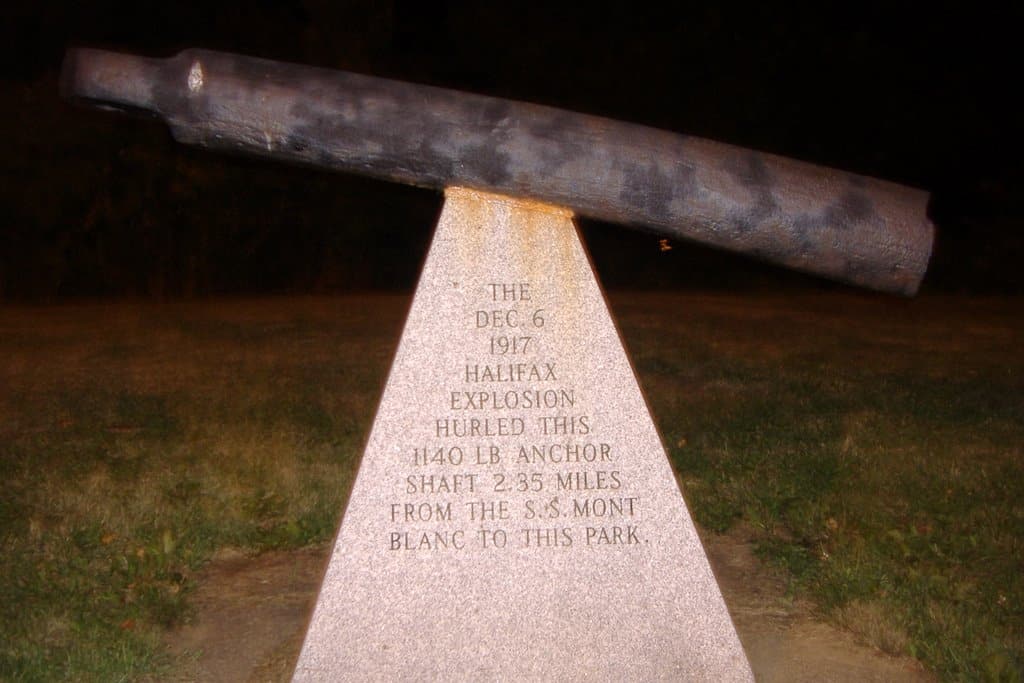
The tragedy is deeply woven into the fabric of Halifax and is thoughtfully chronicled at the Maritime Museum of the Atlantic. Across the city, you can still find relics from that day preserved as memorials—including twisted fragments of the ships themselves, flung for miles by the force of the blast.
On my last visit to Halifax, I sought out the anchor of the Mont-Blanc, which was hurled over 3 km from the blast site and now rests quietly in a small park at 5715 Young Street. Standing there, it’s hard not to feel the weight of history—and maybe, just maybe, hear the echo of a song like Scared in the silence.
Newfoundland Paused
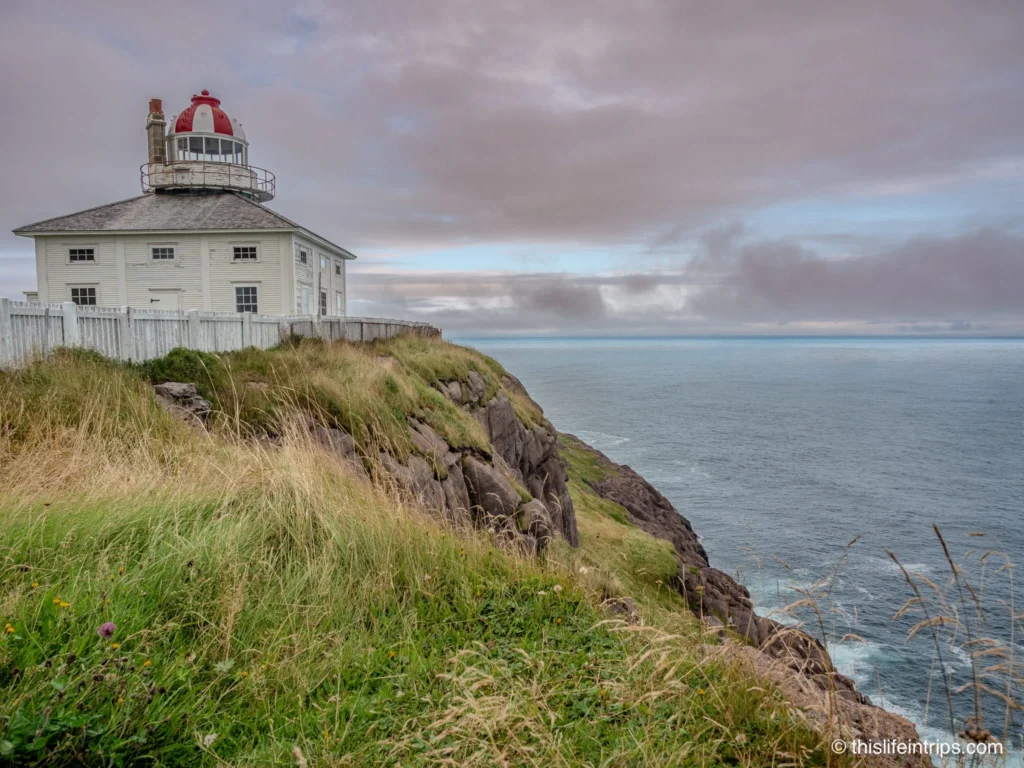
Newfoundland is home to Cape Spear, which I’ve visited a couple of times. Whenever I make the drive to Canada’s easternmost point, I make sure In Violet Light’s Silver Jet is blaring from the speakers. The scenery on the drive is breathtaking, with rugged shores and the endless Atlantic stretching into the horizon. It’s a place that feels like the edge of the world—exactly the kind of imagery The Hip captured so well in their music.
The song The Dire Wolf weaves together Newfoundland folklore, maritime history, and the province’s iconic Newfoundland dogs. It also name-drops real locations, adding to its rich storytelling.
Rick Mercer once shared a great story about how Gord Downie, ever the perfectionist, called him up to make sure he was pronouncing Isle aux Morts correctly. That call led to Rick connecting Gord with his father for a chat—one that turned into a story worth telling.
Gord Downie’s ability to weave these elements into poetic, haunting narratives makes these songs a perfect companion when exploring the province’s stunning landscapes.
Northwest Territories: My Gord Downie Story

It was the summer of 2001, and Gord Downie was on tour supporting his first solo project, Coke Machine Glow, with a stop in my hometown of Yellowknife. He was playing Folk on the Rocks, the annual music festival I had performed at twice not too long before.
With my buddy John, we made the trip home for what was the concert of the year. On top of that, my brother casually mentioned that he had been hired to take Gord and his backing band, The Dinner is Ruined, out fishing on Great Slave Lake. While there was no room for me to tag along, we rushed down to the docks anyway, hoping for a chance encounter. Along the way, we grabbed a couple of beers and some CDs to get signed—just in case.
Like a couple of starstruck schoolkids, we waited. Then, Gord and company arrived. We quickly offered them a beer—then stood there, awkwardly sipping, not saying a word. I could tell Gord could feel our eyes on him, and he seemed just as shy and reserved as we were. Finally, I thought, Screw it.
I reached out my hand, introduced myself as a big fan, and immediately felt the tension break. Offstage, Gord was as chill and unassuming as they come. We made small talk about fishing, and he mentioned that he was in good hands for the day. He smiled, signed my CD—crossing out the title and writing “Shaun’s Book” in its place—then thanked us before heading off. We stood there, grinning like idiots, giggling over what had just happened.
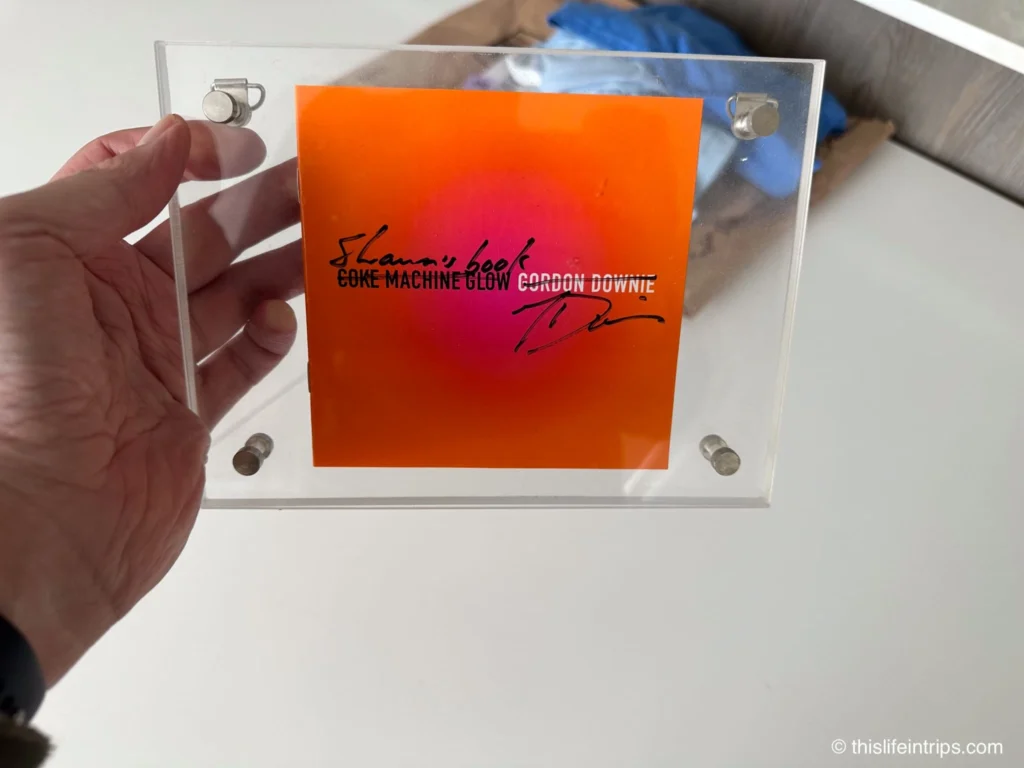
The Open Mic
Before they left, we mentioned to Gord and his band that there was an open mic night at a small local bar later that evening. It was a tiny place—maybe 50 people max—and I was already planning to play. I remember thinking, How cool would it be to have a beer with Gord Downie? Better yet—what if he showed up at the open mic?
Sure enough, as I was wrapping up our last song, in walks Gord. Without missing a beat, I waved him over and handed him the guitar.
So technically, I can say that I opened for Gord Downie. 😉
In true Downie fashion, he and his band launched into an impromptu jam, with one of his legendary rants in the middle. My ears perked up when he started rambling about catching a monster pike earlier that day.
I later caught up with my brother to hear how the fishing trip went. He said Gord thanked them about a hundred times, and that his bass player reeled in a 17-pound northern pike. I always knew he pulled from real life, but to see this art in work was truly special. The night was surreal. One of those moments you never forget.
And the cherry on top? Our mention of the open mic night made it into Michael Barclay’s The Never-Ending Present, a great book on the Tragically Hip’s life and legacy. A full-circle moment I never could have imagined.
My Interview on The Tragically Hip Top 40 Countdown Podcast
Speaking of my Gord Downie encounter… I had the chance to share that story—and plenty more—on The Tragically Hip Top 40 Countdown Podcast. If you’ve ever wondered what it’s like to run into Gord Downie and Rob Baker in unexpected moments, or how The Hip’s music has shaped my travels, this conversation is full of personal anecdotes, laughs, and a deep dive into the band’s lasting impact.
I also highly recommend checking out this podcast, along with the other Tragically Hip-themed ones Jamie has created. Fully and Completely takes listeners through The Hip’s discography, album by album, sharing fascinating tidbits and behind-the-scenes stories along the way. And for those looking to dive deeper into Gord Downie’s solo work, Jamie’s dedicated podcast is a must-listen, helping Hip fans discover (or rediscover) the artistry and storytelling that went beyond the band.
These podcasts have been a fitting soundtrack to multiple cross-country road trips for me. There’s nothing quite like driving through the landscapes that The Hip sang about while listening to deep dives into their music and history.
Yer Tragically Hip Travel Bucket List Journey

So, where will your Hip pilgrimage take you? Will you stand in Market Square in Kingston, where the final concert brought a nation together? Will you make the drive to Bobcaygeon, look up at the constellations, and feel the weight of those famous lyrics? Maybe you’ll head to the rugged cliffs of Cape Spear, where the Atlantic wind echoes Silver Jet as it meets the land’s edge.
The beauty of The Tragically Hip is that their music isn’t just about places—it’s about the moments, the feelings, and the stories behind them. Whether it’s the bitter cold of northern Alberta, the vastness of the Prairies, or the neon glow of a Toronto bar, their songs make you feel like you’ve been there, even if you haven’t. And if you have, they make those places feel even more meaningful.
Canada is a vast, beautiful country, and The Tragically Hip’s music has provided a roadmap for exploring it. Their songs guide you not just to places on a map, but to emotions, memories, and history. So hit the road, queue up the playlist, and let the music lead the way.
What say you?
Thoughts on this Tragically Hip Travel Bucket List?
Let’s hear it!
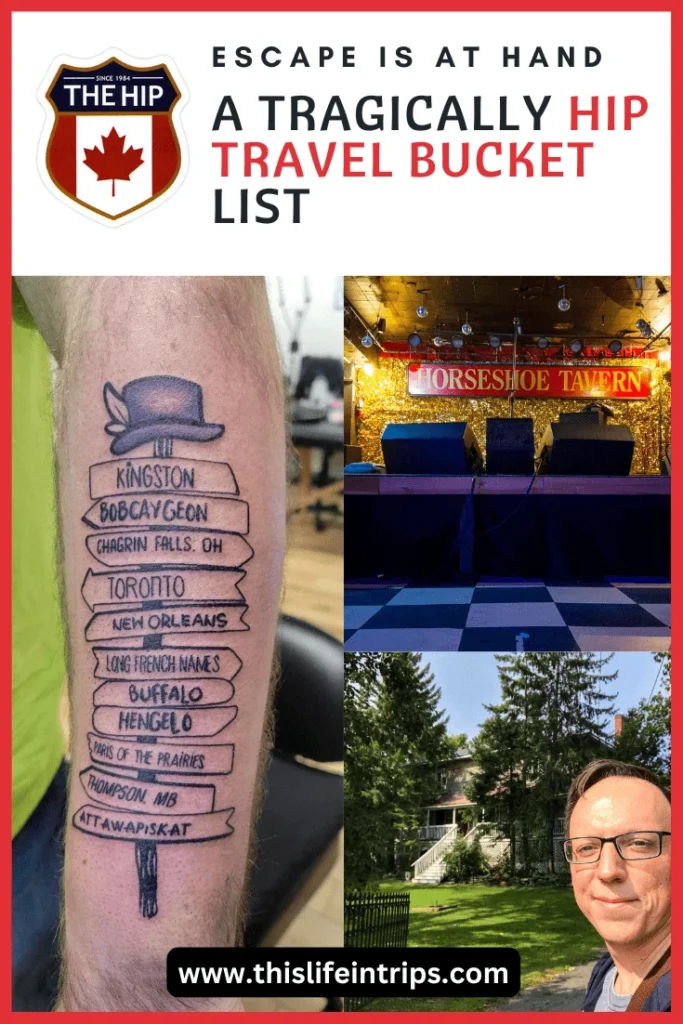
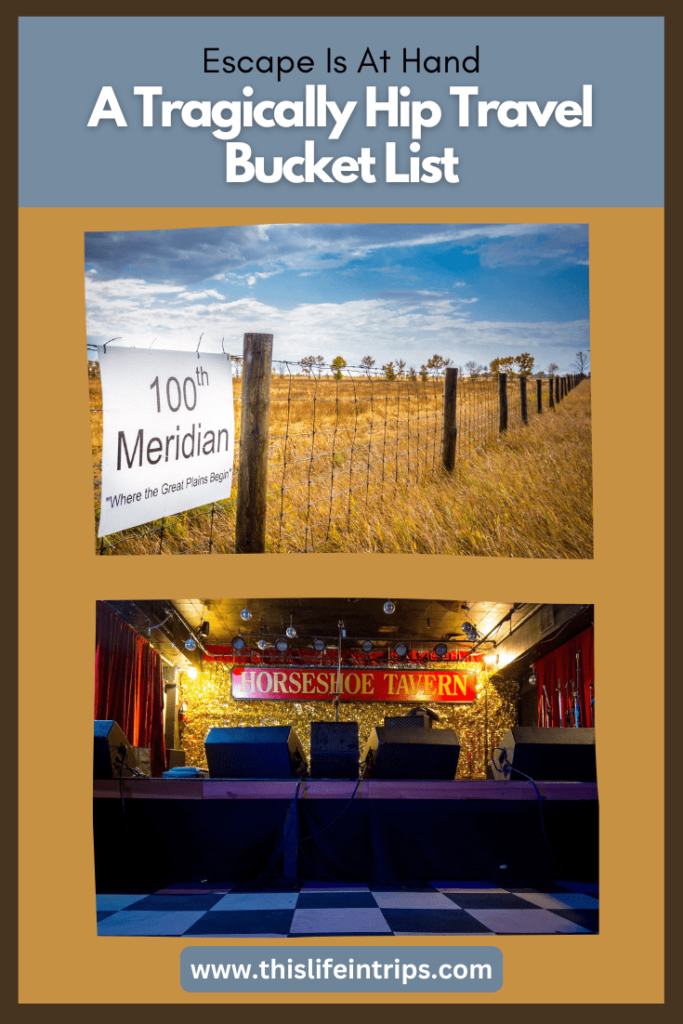
Looking for more Travel Inspiration?

